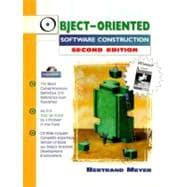
Note: Supplemental materials are not guaranteed with Rental or Used book purchases.
Purchase Benefits
What is included with this book?
BERTRAND MEYER is one of the pioneers of modern software engineering, whose experience spans both industry and academia. He has led the development of successful O-O products and libraries totaling thousands of classes. His Prentice Hall books include Object Success (an introduction to object technology for managers), Introduction to the Theory of Programming Languages, Eiffel: The Language, Object-Oriented Applications, and Reusable Software. He is a frequent keynote speaker at international conferences and consultant for Fortune 500 companies, editor of the Object-Oriented Series, associate member of the applications section of the French Academy of Sciences, chairman of the TOOLS conference series, and editor of the Object Technology department of IEEE Computer.
PART A: THE ISSUES.
PART B: THE ROAD TO OBJECT ORIENTATION.
PART C: OBJECT-ORIENTED TECHNIQUES.
PART D: OBJECT-ORIENTED METHODOLOGY: APPLYING THE METHOD WELL.
PART E: ADVANCED TOPICS.
PART F: APPLYING THE METHOD IN VARIOUS LANGUAGES AND ENVIRONMENTS.
PART G: DOING IT RIGHT.
PART H: APPENDICES.
The New copy of this book will include any supplemental materials advertised. Please check the title of the book to determine if it should include any access cards, study guides, lab manuals, CDs, etc.
The Used, Rental and eBook copies of this book are not guaranteed to include any supplemental materials. Typically, only the book itself is included. This is true even if the title states it includes any access cards, study guides, lab manuals, CDs, etc.